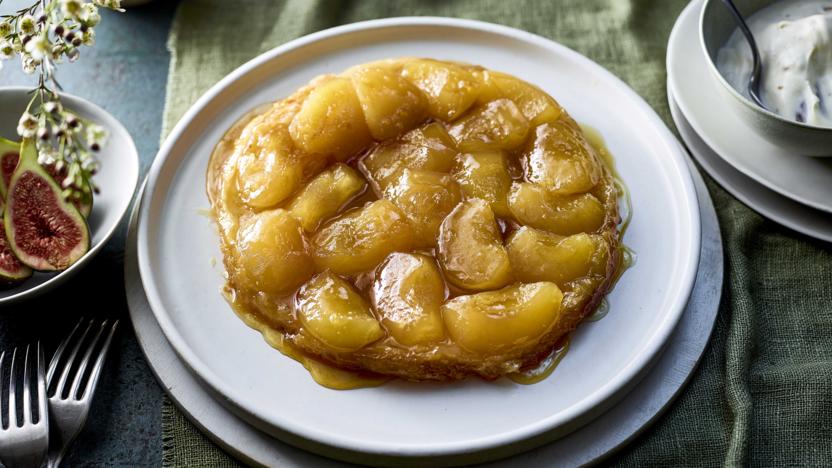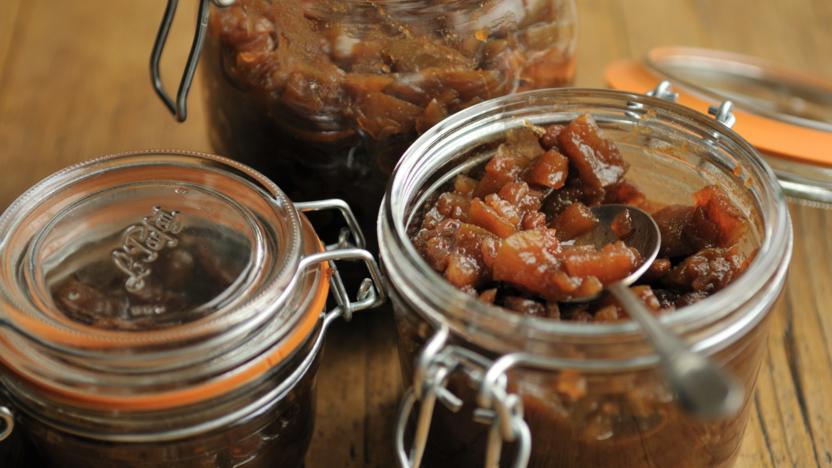Apple recipes
Make the most of the British apple season with our delicious apple recipes. Try a comforting crumble or pie or make the season last with a spicy chutney.
This is the easiest apple crumble recipe and an all-time favourite quick and easy dessert. See the recipe tips for little tweaks you can make to get this absolutely perfect.
Each serving provides 618 kcal, 6g protein, 83g carbohydrates (of which 43g sugars), 28.5g fat (of which 18g saturates), 3.5g fibre and 0.21g salt.
More apple recipes
Buyer's guide
Around 2,300 kinds have been bred in Britain, of many different colours, shapes, textures and tastes, and a revival in heritage varieties mean there are more types available in good greengrocers, farmers' markets and farm shops, as well as in some supermarkets. The flavours of traditional apples range greatly, from the freshly fragrant with hints of strawberries to the full-bodied, nutty and spicy types that come later in the season.
There are two types of apples: eating apples and culinary (cooking) apples. Eaters are sweeter, with the most interesting flavour, as their sugars are balanced by an edge of acidity. They hold their shape well in cooking, making them the best choice for a French apple tart, a tart tatin or other continental recipes, which developed in countries without a tradition of culinary apples. Examples of popular eaters are: Granny Smith, Cox's Orange Pippin and Golden Delicious.
Culinary apples are larger and more acidic. Their sourness mellows upon cooking, so you may not need to add as much sugar as you thought to a dish. A cooking apple will become more like an eater in storage because the acids lessen over time. Some apples are termed dual-purpose, and these are best for cooking when young and for eating when older. The most popular British culinary apple is the Bramley apple.
Most commercial fruit is picked under-ripe and put into controlled atmosphere storage (keeping the apples in air that has a high concentration of carbon dioxide), some of it for as long as six months. Some imported apples may have artificial wax on the outside to keep them looking fresh. The very best fruit is tree-ripened and recently picked.
For the ultimate freshness, there are now a number of community, public and commercial orchards where you can pick your own fruit. Gently cup the fruit in your hand and twist slightly. If the stalk comes away easily from the tree, the apple is ready. Seek out apples that are firm, with smooth and unblemished skin.
Early varieties, such as Discovery, Beauty of Bath and Worcester Pearmain, ripen in late summer and tend to be brightly coloured - sometimes with red blushing into their flesh - sweet, juicy and with a natural waxiness.
Mid-season fruit, such as Lord Lambourne and Peasgood Nonsuch, are harder-skinned, with firmer fresh and will keep for longer.
The late-season apples, such as Ashmead's Kernel, Blenheim Orange, Cornish Gillyflower, D'Arcy Spice and Pitmaston Pine Apple, are very rich in flavour, often drier in texture and more likely to be russeted (slightly or entirely rough on the skin).
Storage
Apples store well for months if unblemished. Wrap each one in dry newspaper and then place in a single layer in the bottom of a wooden crate or shallow cardboard box. Place in a cool, dry, dark, airy place. Check them regularly and immediately throw out any that have rotted. As a rule, the later an apple ripens, the longer it will keep.
Preparation
Pair caramelised apple slices with fatty meats such as pork to offset the richness, or bake them into any number of pies, tarts and puddings with a touch of cinnamon.






























